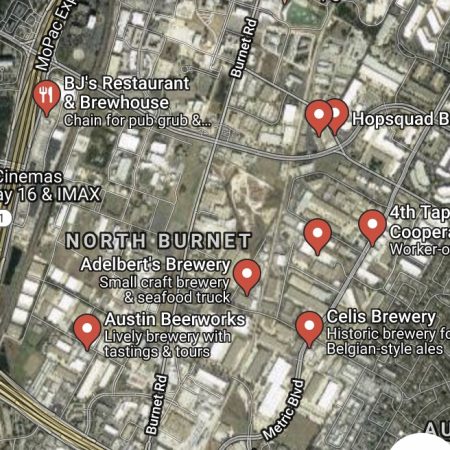by Lee Nichols
One of my favorite sayings is “the perfect is the enemy of the good.”
I usually apply it to politics, when I’m annoyed at those who demand ideological purity and refuse to consider a candidate who is actually electable.
I think it may apply to our Major League Soccer stadium search, as well.
On Tuesday, City of Austin staff released a map of public properties that might be used for the Columbus Crew if the team relocates here, including five possible stadium sites.
A couple caught soccer fans completely by surprise, and one in particular really grabbed my eye: 10414 McKalla Place, in north Austin. I’d like to present the argument in favor of it.
This will not be a vociferous endorsement. That may sound strange, but let’s face it: we know what the perfect site is. It’s Butler Shores. You’ve seen the rendering of the proposed stadium for that site. It’s beautiful – both the stadium itself and the skyline views it would offer to television and spectators.
But supporters of Butler Shores had better gear up for a vicious political fight.
I disagree with many of Butler’s opponents, both philosophically and factually. But I’m not going into that here. The important point for this blog post is that soccer fans need to know that, whether they are right or wrong, the opponents’ beliefs are very sincerely and fiercely held, and neighborhood/green space protection activists are a powerful voting bloc in this city. I know this from 31 years of living here, including a decade and a half as a local politics reporter for The Austin Chronicle.
Regardless of how Precourt Sports Ventures tries to make Butler happen – whether via a City Council decision or a public vote – it will have to win over, not roll over, those citizens. PSV damn sure won’t be able to just buy an election – look what happened to Uber and Lyft. Those companies came in full of arrogance and got slapped down at the polls (they finally got what they wanted, but only via the sleazy path of getting the Texas Legislature to overrule Austin voters).
So let me speak up for McKalla Place. No, it’s not perfect. But it’s good. Here’s why:
1. No political fight.
This is the big one. First off, it’s not on parkland. That’s huge. Secondly, look at the tract on a satellite map – there are no neighborhoods immediately adjacent. It’s surrounded by a warehouse district. Yes, that’s also a knock against it (I’ll address that next), but for political purposes, it’s a bargain. Yes, I’m sure someone from the neighborhood will complain – this is Austin, after all – but with a buffer of nearly a mile between the stadium and houses, any opposition will be marginal at best.
2. Entertainment options.
They’re small so far, but quality. Soccer fans like their beer, and this tract is right smack in the middle of what I affectionately call the “Brewery Ghetto.” There are no less than six breweries within walking distance of McKalla, and a seventh nearby. (See the red pinpoints here.) And of course, the Domain is very close by. Love it or hate it, the Domain is emerging as a serious entertainment destination. Put the stadium here, and I’m willing to bet the warehouses fade away and the entire region transforms into an entertainment district. Yes, there is a valid argument that the area is not “walkable,” but that’s fixable.
3. It’s within the “urban core.”
No, not according to the city’s map, but frankly, I take issue with the city’s definition. The geographic population center of the Austin Metropolitan Statistical Area is at Burnet and North Loop, just five miles south of McKalla – or, put another way, a quick ride down the road on the 803 MetroRapid Bus. In any case, it’s barely outside the city’s defined area. I’ve seen some predictable complaints that it’s “too far north.” Frankly… whatever. We aren’t talking about the FC Dallas fiasco in Frisco. McKalla is well within the Austin city limits, not Georgetown or San Marcos. People who really want to see pro soccer will get there. And speaking of mass transit…
4. It’s literally right on the rail line.
Kramer Station is only a block north. Build the stadium at McKalla, and you could relocate Kramer Station to the front gate. Five Capital Metro routes service the tract (including the heavily used 3 and 803). The most important route in the city, the 1, also comes reasonably close.
5. It also has room for parking.
Yes, the hardcore urbanist crowd views autos and mass transit as almost mutually exclusive. And I believe the neighborhood activists’ fears of traffic overrunning the Butler area are overblown. But I think what the majority of potential MLS fans want is to just get to the game in the way that suits them best. Personally, I’ll take the 803 from my Crestview neighborhood. But let’s also provide reasonable accommodations for folks coming in from Round Rock, Leander, and Buda. This team’s fan base will not be exclusively condo-dwelling downtowners.
No, McKalla won’t have those amazing downtown views. And even more importantly, it’s not the stated preference of Precourt. But it might be what’s doable. I’m assuming Anthony Precourt is going to read this, so let’s invite him: Mr. Precourt, make a visit to the McKalla tract. It won’t look very impressive. But try to see its potential, not just its present.
Perhaps I’m aiming too low. Austin aspires to be a world-class city, and a stadium on Lady Bird Lake would be a world-class jewel. But soccer fans, you need to understand – there are a lot of Austinites who don’t give a crap about our MLS dreams, and if you think you’re going to persuade them, you’re kidding yourselves. You’re probably also kidding yourself if you think you’re going to outvote them.
If you (I’m also talking to you, Mr. Precourt) have the steel for this fight, then have at it. But I truly believe it can be avoided… and we can still have the pro soccer experience that other great American cities currently enjoy.


Good article. And although I think the butler shores could be a beautiful location, coming from pflugerville I’d be more likely to go to McKalla place more often than butler shores just due to the ability to park near the rail and take it down without dealing with any traffic.
I agree with all the the points made here. When I first heard of Butler as an option, I was baffled by the logistics of getting to and from the stadium on game day. Though the beauty of that location or another one on the lake would be terrific. The McKalla site surprised me as well. I have thought about a stadium placed nearby the Domain before but was not sure were the stadium would be located. I liked the idea of this area for its practical attributes. The main one I considered is the area is close to the major roads : MoPac, 183, 35, and 360.
Good lord.
Yes, you can improve walkability (although you won’t, at this spot, because walkability requires the elimination of surface parking lots and usually parking garages too). But even more fundamental: You can’t fix bad bones, and this area is a bad graveyard.
Ignoring the stated preference of the team for what is “doable” is even less likely to succeed than beating Ann Kitchen. This is the same thing as the blazer crowd telling Amazon they should locate HQ2 at the interchange of SH45 and SH130 because it has great freeway access.
You are 100% correct about Austin rejecting any stadium at Butler. I just don’t understand why there isn’t more enthusiasm for the Guerrero park site. Its much larger, in the urban core, has plenty of room for parking, is within an easy walk of multiple public transportation routes, including the train, and the butler hike and bike trail, its on the river, offers great views of downtown, has multiple highway and thoroughfare transportation options, and would be much less objectionable to Austin voters.
Walter: Guerrero is not walking distance from the train. (I’m not necessarily arguing against Guerrero, just pointing out that the train is not really a transportation option there.)
Point of order: if the warehouses go away, so do the breweries. The State of Texas, in its very finite wisdom, has declared that microbreweries (not brewpubs) must be located in commercial warehouse districts.
Where is that in the legal code? (I’m not saying you’re wrong, I just want to be able to read that law. As I’m a semi-professional beer writer, I want to know what state code to reference.)
The nearest condos are at the Domain. Homes are over a mile away.
This site is surrounded by roads, storage sheds, and strip warehouses.
This isn’t the “warehouse” district in Dallas. This site is NOT walkable.
The suggestion that surrounding the stadium with parking lots is a good idea is not convincing to me.
Sounds just like Frisco except closer in to the inner loop.
The site is also large enough that it could contain an on-site entertainment district about the same size as Rock Rose. Cap Metro has already proposed moving the Kramer Station to the Brandywine Tract and adding an additional one immediately adjacent to this property. If the stadium was sited on the west edge of the tract, a street lined with bars and restaurants built into the ground floor of parking structures could lead between the stadium and rail station. There are apartment buildings under construction immediately to the north and south of the tract, and an office building is proposed immediately to the west.
Before the city released its maps, the only two viable locations were downtown or near the domain. I wasn’t sure if there was a suitable parcel, but apparently there is, and it is right next to the train station and breweries!!!!! As much as I personally want the stadium at Butler Shores, it would be better for the city to put it here. Downtown doesn’t need the development, but this area could really use a project like this. The “bones” of the area aren’t that bad since most the parcels are still huge. This more easily allows for retrofitting and re-design (where as a residential subdivision is almost impossible to re-design). I’m a huge soccer fan, but also a city planner, and this area will be very different 10-20 years from now. It could be very urban with multi-modal transport and live/work/play mix of uses. That is what MLS wants, vibrancy, much more than being “central”. The existence of this site makes it much harder, politically, for council to approve the leasing of Butler Shores. If Precourt is smart, he plays hardball, using the “centrality” argument as leverage, and gets the land for pennies on the dollar.